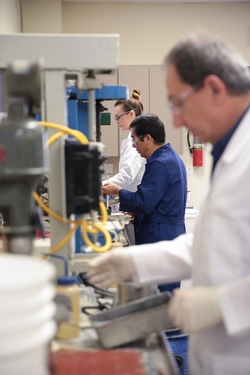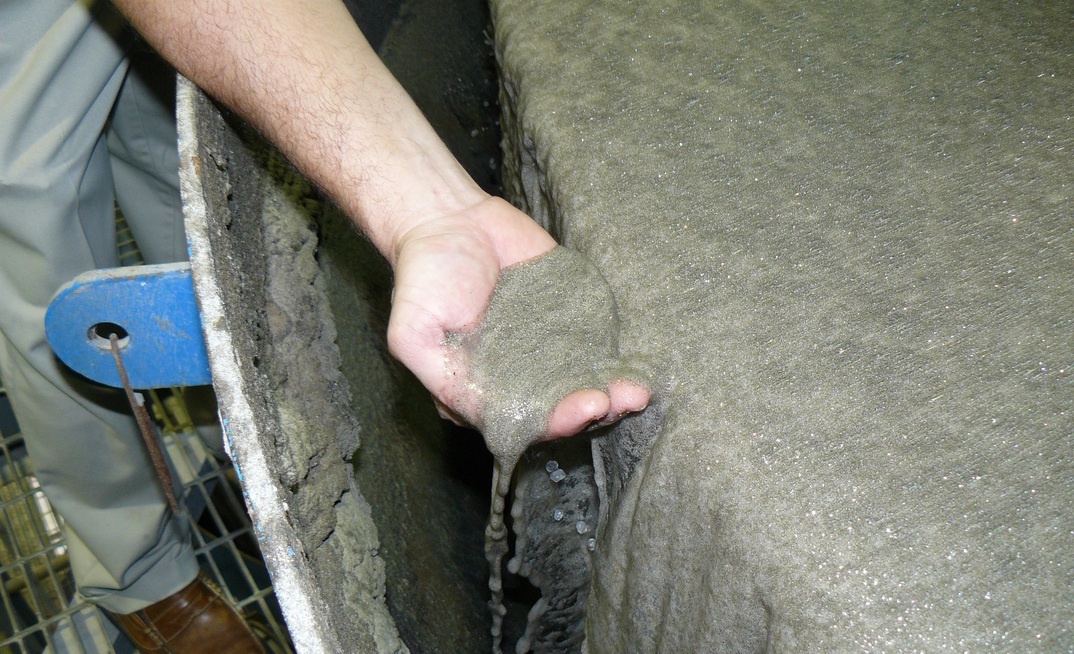Which types of reagents are most commonly used in flotation?
Successful flotation separation depends on the range of chemical reagents added to the system to control surface behaviour of minerals in the ore and the aqueous chemistry in the bulk.
Design of chemical reagents for flotation requires deep understanding of both these fundamentals and then the operating conditions to provide optimum grade, recovery and economics of the beneficiation process.
The most common type of reagents used for industrial mineral flotation are anionic in nature. They are made up of various types of fatty acids derived from animal and vegetable sources.
Reagent selection is based on sampling the mineral and doing laboratory flotation to screen the type of reagent and its application for direct or reverse flotation. Based on the characteristics of the surface of the mineral, one will determine the type of reagent needed.
In some cases a cationic reagent is needed. Most cationic reagents are based on amine chemistry. Coupling the amount and type of reagent to the flotation equipment often determines the optimum economics for the process. For example, the use of specially blended frothers for column applications is as important as the collector itself.
ArrMaz custom blends reagent for each mineral and the flowsheet connected to it. In addition, there are valuable synergies the can be obtained by integrating the characteristics of the collector, frother, pH modifier, float oil, and various flotation aids together to produce maximum collection potential. Often reagents working together will improve the transfer of the mineral out of the aqueous phase into the froth zone where is can be selectively collected.
What role do the reagents perform and how important is it that the right one is chosen?
Without the collector there is no process. Chemical reagents produce the hydrophobic film on the mineral particle surfaces. It is the primary driving force that initiates the flotation process. Collectors selectively coat the surface of one mineral we want to float, making it hydrophobic. The particles are more willing to attach to a bubble and float out of the bulk.

Discovering your ore’s potential relies on finding a collector that can maximise plant performance. In many cases, a generic anionic/cationic collector will work, but to reach recoveries greater than 90% and acceptable grades, choosing and continually optimising the reagent formula is key.
To add further value, specialists like ArrMaz can guide operations on how to change their operating parameters to better match the ability of the reagent to the plant. Often a small change to the density of the operation or amount of air introduced to the float machine will lead to better reagent performance and better metallurgical results.
Are there any common pitfalls that mines make when selecting reagents and how can these be avoided?
The most common mistake is to view the reagent as a commodity and to source it based on low unit cost. Many folks in the industry will say, “a little bit of recovery will pay for a lot of reagent” and “that better recovery is often driven by reagents that work better”.
Mining chemicals are designed for the mineral and the unique characteristics of the plant equipment. The personnel operating the plant can tell the difference between a good reagent and a better one.
A big mistake that some mines make is to not include the operators when selecting a reagent. Often purchasing and higher level managers are not in tune with how the plant operates and the demands it puts on a reagent.
If a reagent is selected based on strictly price or budget goals, often the plant suffers from sub-optimum recovery and grade. It is best to let the folks who are running the plant chose which reagent to run.
Sometimes we see that management puts a limit on the amount of reagent that can be used, such as the dose per tonne. Many times we see valuable minerals that should be floated going out with the tails because the operators have their hands tied on what the reagent dose should be. Again, in almost every case, using a little bit more reagent to improve recovery or grade will more than pay for itself.
How often should clients reassess the reagent formulation/quantities they are using?
ArrMaz advises that mining reagents need to be constantly tested in the lab and in the plant to improve performance. We suggest a monthly review of the mineral with lab flotation to see if an improved or varied formula gives better results. Once the lab proves a better reagent is possible, then the plant needs to test it promptly. Developing a robust reagent that is forgiving of potential surprises in the inevitable variability of the ore is the goal.
The process design, engineering and construction should be co-ordinated carefully with a deep understanding of the process mining chemical universe. ArrMaz is the type of company that can advise on the best fit for reagents, and formulate chemicals to adapt to the changing orebody and process issues. The goal is better grade and recovery in an existing operation with the same or better cost performance.
Many times a mining operation cannot afford to spend the necessary capital to improve the process, and often a higher performing reagent can do the task of better grade and recovery on a challenging ore, producing better economic value.
How common is it to use custom blends?
Every product we offer is specifically designed for each mine’s mineral and flowsheet. We then test the formulation in the plant to ensure the proper fit. If needed, we can determine via plant testing if adjustments to froth characteristics and/or collecting nature need to be made and formulas changes are implemented. We are expert at solving unique plant problems with a chemical solution, for example, we had a customer who was experiencing a foam problem in waterway ditches and in key process areas. ArrMaz designed a unique environmentally friendly water based defoamer to eliminate the problem.
You mention that it’s important to optimise the reagent scheme in tandem with the flow-sheet. Could you expand on this?
The future will be the ability for both process design and reagent development to effectively work together to efficiently recovery ever lowering ore quality.
Many of the high-quality deposits are already mined out. Flotation appears to be the most economic way to process lower quality minerals, and successful flotation is linked to being able to economically liberate the impurities from the mineral, then design a flow sheet and reagent system to float the impurities away. Managing water quality and quantity is critical to flotation, and reagents must be designed to consider the water chemistry.
We believe it is critical for reagent companies, mining companies, and engineering companies to work in close co-operation to develop an optimised flotation system. This co-operation is not a one-time event, but a long-term collaboration as ore quality changes over time.
As new ores are investigated and flotation projects are designed it would be ideal to include the design of the reagent into the project so that the flow sheet and the reagent’s capability can be matched. This would increase the success of the project and shorten commissioning times.
Do you have any new products for the flotation market?
ArrMaz has developed an innovative barite flotation process along with a new collector, CustoFloat 5920, which shows great potential for barite beneficiation. Lab results demonstrate the process enables a producer to recover barite from impurity minerals to a desired higher specific gravity with mass yield recoveries above 90%. The process will allow barite to be mined efficiently from deposits that are currently under utilised.
Turkish sand producers have traditionally used a collector in a very acidic float process to remove impurities. ArrMaz has developed a new collector that can float in neutral environments. CustoFloat 588 yields better cost performance by increasing first-stage yield and decreasing acid needs, significantly reducing costs while creating a safer work environment.
Feldspar studies have also resulted in the reduction of the number of reagents and thedose needed to remove heavy minerals and mica. A new collector, CustoFloat AK5, along with a single reagent float process, replaces the traditional two-step reagent dosing of anionic and cationic collectors.
This new collector uses half the dose of the standard Prina Oil and is more effective at removing titanium/iron. CustoFloat AK5 also provides cost-performance improvements.
Lab results show this new collector increases the speed of the float and can improve process throughput.
























